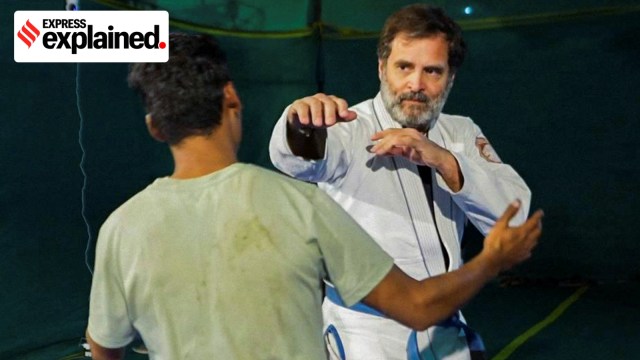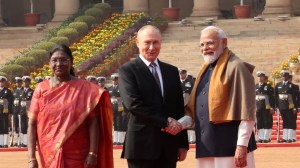What are jiu-jitsu & aikido, practised by Rahul Gandhi during Bharat Jodo Nyay Yatra
Both jiu-jitsu and aikido are forms of martial arts which originated in Japan, with an emphasis on grappling, weight and energy manipulation.
 Rahul Gandhi has said a "Bharat Dojo Yatra" is coming soon. (Screengrab/PTI)
Rahul Gandhi has said a "Bharat Dojo Yatra" is coming soon. (Screengrab/PTI)Rahul Gandhi, the Leader of Opposition in Lok Sabha, said on Thursday (August 29) that during his Bharat Jodo Nyay Yatra earlier this year he had “a daily routine of practising jiu-jitsu every evening” which brought together young martial arts students from towns where they stayed.
“Our goal was to introduce these young minds to the beauty of the ‘Gentle Art’ — a harmonious blend of meditation, jiu-jitsu, Aikido, and non-violent conflict resolution techniques. We aimed to instill in them the value of transforming violence into gentleness, giving them the tools to build a more compassionate and safer society,” he posted on X, adding that a “Bharat Dojo Yatra is coming soon”.
During the Bharat Jodo Nyay Yatra, as we journeyed across thousands of kilometers, we had a daily routine of practicing jiu-jitsu every evening at our campsite. What began as a simple way to stay fit quickly evolved into a community activity, bringing together fellow yatris and… pic.twitter.com/Zvmw78ShDX
— Rahul Gandhi (@RahulGandhi) August 29, 2024
Dojo in the Japanese language refers to a place of learning martial arts, somewhat like an akhada for kushti (wrestling) in India.
Here is a brief introduction to the martial arts that Rahul referred to.
Jujutsu: the ‘gentle art’
A family of martial arts originating in Japan, jujutsu translates to “gentle art” — “ju” means “soft/ supple/ gentle” and “jutsu” means “art/technique”. Jiu-jitsu is a somewhat inaccurate (in terms of pronunciation), albeit popular Romanisation of the Japanese word.
The most commonly accepted story of jujutsu’s origin dates to late 16th century Japan, during the age of the samurai — Japan’s warrior class which held significant political power between the 12th and 19th centuries.
It is believed that samurai warriors developed various grappling and self-defence techniques for situations in which they lost their weapons (the legendary katana swords) during battle.
Since striking with bare hands against heavily armoured opponents — as the samurai were during battle — was ineffective, practitioners came up with more efficient ways of neutralising the opponent in the form of pins, joint locks, and throws. At the heart of these techniques was the principle of manipulating the opponent’s energy against them, rather than directly opposing it.
Jujutsu’s many offshoots
Over time, as jujutsu became popular in Japan and overseas, multiple offshoots were born, which influenced various other combat sports. These include:
- Judo, which was developed in the late 19th century from several traditional styles of jujutsu, and became an Olympic sport in the 1964 Tokyo Games;
- Sambo, a combat sport developed by the Soviet Red Army in the 1920s to improve soldiers’ hand-to-hand combat abilities;
- Brazilian jiu-jitsu was developed in the 1920s, and is today one of the most popular self-defence styles, which revolves around the principle of a smaller, weaker person defeating a bigger, stronger opponent with the help of leverage and weight distribution; and
- MMA or mixed martial arts, the most popular combat sport today, borrows heavily from jujutsu and other styles which it has influenced.
Interest in jujutsu, especially the modern Brazilian form, skyrocketed after Royce Gracie’s legendary performance in the first United Fighting Championship (UFC) in 1993. Gracie methodically defeated much larger and stronger opponents while barely throwing around any kicks and punches, and relying instead on submission holds.
Aikido: The art of not hurting one’s foe
Aikido is an offshoot of jujutsu. It was developed by martial artist Morihei Ueshiba in the early 20th century, which makes it among the youngest of Japan’s many martial arts. Aikido literally means the “way of harmonising energy”, and is different from most other martial arts.
It takes jujutsu’s principle of manipulating an opponent’s energy to its logical extreme. Aikido’s goal is to end conflict non-violently — to deflect strikes rather than overpower one’s adversary, and to “match the opponent’s force”. The idea is to not only defend oneself, but to also protect or not hurt the attacker.
According to a phrase often used by Ueshiba, “true victory, final victory over oneself, here and now” — meaning that an Aikido practitioner’s primary goal is to overcome oneself rather than cultivating violence or aggression.
This is why there are no aikido competitions. Rather, practitioners carry out demonstrations, and engage in a number of practices for their holistic mental and physical growth.
Some have criticised aikido’s worth as a real-world fighting technique, arguing that aikido practitioners cannot hold their own against other, more violent forms of fighting. However, others argue that the skills and discipline that aikido inculcates are extremely important not just for self-defence but also for life.
Rahul Gandhi is a black belt in aikido, which denotes the highest level of technical proficiency in the martial art.
- 01
- 02
- 03
- 04
- 05






































